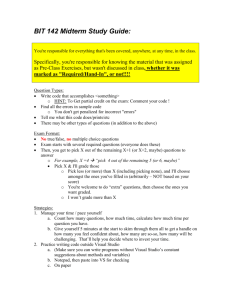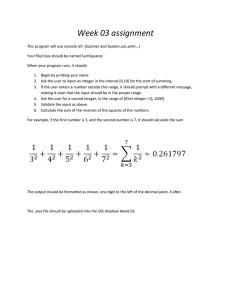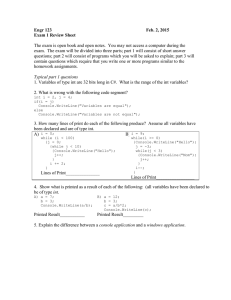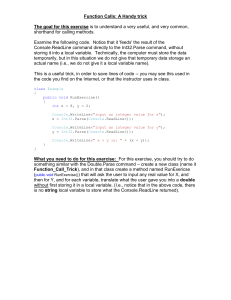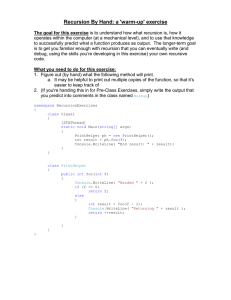Chapter 4: Control Structures: Part 1
advertisement
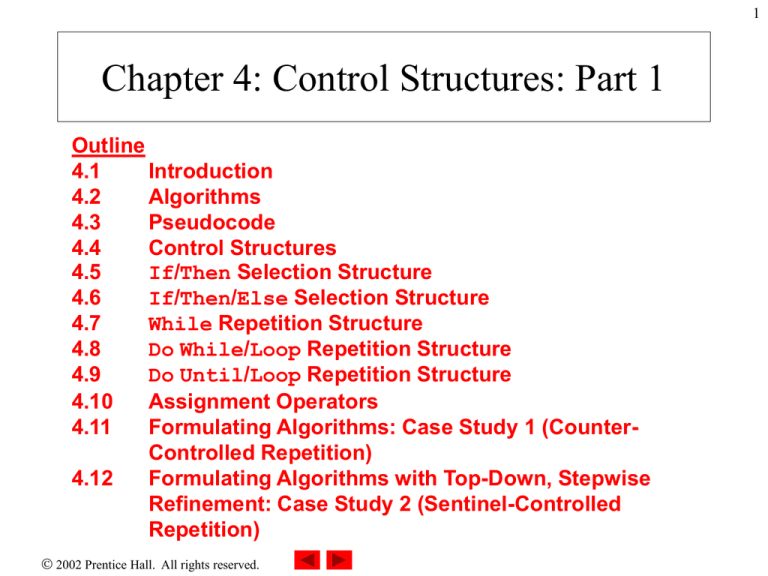
1
Chapter 4: Control Structures: Part 1
Outline
4.1
Introduction
4.2
Algorithms
4.3
Pseudocode
4.4
Control Structures
4.5
If/Then Selection Structure
4.6
If/Then/Else Selection Structure
4.7
While Repetition Structure
4.8
Do While/Loop Repetition Structure
4.9
Do Until/Loop Repetition Structure
4.10
Assignment Operators
4.11
Formulating Algorithms: Case Study 1 (CounterControlled Repetition)
4.12
Formulating Algorithms with Top-Down, Stepwise
Refinement: Case Study 2 (Sentinel-Controlled
Repetition)
2002 Prentice Hall. All rights reserved.
2
4.13
4.14
4.15
Formulating Algorithms with Top-Down, Stepwise
Refinement: Case Study 3 (Nested Control Structures)
Formulating Algorithms with Top-Down, Stepwise
Refinement: Case Study 4 (Nested Repetition
Structures)
Introduction to Windows Application Programming
2002 Prentice Hall. All rights reserved.
3
4.2 Algorithms
• Algorithms
– A procedure for solving a problem, in terms of
• The actions to be executed and
• The order in which these actions are to be executed
2002 Prentice Hall. All rights reserved.
4
4.3 Pseudocode
• Pseudocode
– Informal language to helps programmers develop algorithms
– Not executed on computers
– Helps conceptualize a program during the program-design
process
– Describes only executable statements
2002 Prentice Hall. All rights reserved.
5
4.4 Control Structures
• Transfer of control
– GoTo statement
• It causes programs to become quite unstructured and hard to
follow
• Bohm and Jacopini
– All programs could be written in terms of three control
structures
• Sequence structure
• Selection structure
• Repetition structure
2002 Prentice Hall. All rights reserved.
6
4.4 Control Structures
• Flowcharts
– Graphical representation of an algorithm
– Drawn using certain special-purpose symbols
•
•
•
•
Rectangles
Diamonds
Ovals
Small circles
2002 Prentice Hall. All rights reserved.
7
4.4 Control Structures
Fig. 4.1
add grade to total
total = total + grade
add 1 to counter
counter = counter + 1
Flowcharting Visual Basic’s sequence structure.
2002 Prentice Hall. All rights reserved.
8
4.4 Control Structures
• Selection Structures
– If/Then
• Single-selection structure
– If/Then/Else
• Double-selection structure
– Select Case
• Multiple-selection structure
2002 Prentice Hall. All rights reserved.
9
4.4 Control Structures
• Repetition Structures
–
–
–
–
–
–
–
While
Do While/Loop
Do/Loop While
Do Until/Loop
Do/Loop Until
For/Next
For Each/Next
2002 Prentice Hall. All rights reserved.
10
4.4 Control Structures
Visua l Ba sic Keyw ord s
AddHandler
AddressOf
Alias
And
AndAlso
Auto
ByVal
CBool
CDec
Class
CShort
Date
Delegate
Each
Enum
Exit
For
GetType
Implements
Integer
Like
Mod
MyBase
Next
NotOverridable
Optional
Overridable
Ansi
Boolean
Call
CByte
CDbl
CLng
CSng
Decimal
Dim
Else
Erase
ExternalSource
Friend
GoTo
Imports
Interface
Long
Module
MyClass
Not
Object
Or
Overrides
As
ByRef
Case
CChar
Char
CObj
CStr
Declare
Do
ElseIf
Error
False
Function
Handles
In
Is
Loop
MustInherit
Namespace
Nothing
On
OrElse
ParamArray
Assembly
Byte
Catch
CDate
CInt
Const
CType
Default
Double
End
Event
Finally
Get
If
Inherits
Lib
Me
MustOverride
New
NotInheritable
Option
Overloads
Preserve
Fig. 4.2
2002 Prentice Hall. All rights reserved.
Visual Basic keywords.
11
4.4 Control Structures
Private
RaiseEvent
Rem
Select
Short
Stop
SyncLock
True
Until
WithEvents
#If...Then...#Else
Property
ReadOnly
RemoveHandler
Set
Single
String
Then
Try
When
WriteOnly
-
Protected
ReDim
Resume
Shadows
Static
Structure
Throw
TypeOf
While
Xor
-=
Public
Region
Return
Shared
Step
Sub
To
Unicode
With
#Const
&
&=
*
*=
/
/=
\
\=
^
^=
+
+=
=
The following are retained as keywords, although they are no longer
supported in Visual Basic.NET
Let
Fig. 4.2
Variant
Wend
Visua l Ba sic keyword s.
Fig. 4.2
2002 Prentice Hall. All rights reserved.
Visual Basic keywords.
12
4.5 If/Then Selection Structure
• A selection structure chooses among alternative
courses of action.
• It is a single-entry/single-exit structure
• Example
If studentGrade >= 60 Then
Console.WriteLine(“Passed”)
End If
2002 Prentice Hall. All rights reserved.
13
4.5 If/Then Selection Structure
Grade >= 60
true
Console.WriteLine(“Passed”)
false
Fig. 4.3
Flowcharting a single-selection If/Then structure.
2002 Prentice Hall. All rights reserved.
14
4.6 If/Then/Else Selection Structure
• Example
If studentGrade >= 60 Then
Console.WriteLine(“Passed”)
Else
Console.WriteLine(“Failed”)
End If
• Nested If/Then/Else structures
– Test for multiple conditions by placing one structure inside
the other.
– ElseIf keyword
2002 Prentice Hall. All rights reserved.
15
4.6 If/Then/Else Selection Structure
Console.WriteLine(“Failed”)
Fig. 4.4
false
Grade >= 60
true
Console.WriteLine(“Passed”)
Flowcharting a double-selection If/Then/Else structure.
2002 Prentice Hall. All rights reserved.
16
4.7 While Repetition Structure
• Repetition structure
– Allows the programmer to specify that an action should be
repeated, depending on the value of a condition
• Example (pseudocode)
While there are more items on my shopping list
Purchase next item
Cross it off my list
2002 Prentice Hall. All rights reserved.
17
1
2
3
4
5
6
7
8
9
10
11
12
13
14
15
16
17
18
19
20
21
22
23
24
Outline
' Fig. 4.5: While.vb
' Demonstration of While structure.
Module modWhile
While.vb
Sub Main()
Dim product As Integer = 2
' structure multiplies and displays product
' while product is less than 1000
The decision is tested
While product <= 1000
time the loop iterates
Console.Write("{0} ", product)
product = product * 2
End While
each
Console.WriteLine() ' write a blank line
' print result
Console.WriteLine("Smallest power of 2 " & _
"greater than 1000 is {0}", product)
Console.ReadLine() ' prevents window from closing
End Sub ' Main
End Module ' modWhile
2 4 8 16 32 64 128 256 512
Smallest power of 2 greater than 1000 is 1024
Program Output
2002 Prentice Hall.
All rights reserved.
18
4.4 Control Structures
product <= 1000
true
product = product * 2
false
Fig. 4.6
2002 Prentice Hall. All rights reserved.
Flowchart of the While repetition structure.
19
4.8 Do While/Loop Repetition Structure
• This structure behaves like the While repetition
structure
2002 Prentice Hall. All rights reserved.
20
1
2
3
4
5
6
7
8
9
10
11
12
13
14
15
16
17
18
19
20
21
22
23
24
' Fig. 4.7: DoWhile.vb
' Demonstration of the Do While/Loop structure.
Module modDoWhile
Sub Main()
Dim product As Integer = 2
Outline
DoWhile.vb
Failure to provide the body of the structure with
an action that causes the condition to become
displays
less than false
1000creates an infinite loop
' structure multiplies and
' product while product is
Do While product <= 1000
Console.Write("{0} ", product)
product = product * 2
Loop
Console.WriteLine() ' write a blank line
' print result
Console.WriteLine("Smallest power of 2 " & _
"greater than 1000 is {0}", product)
Console.ReadLine() ' prevent window from closing
End Sub
End Module ' modDoWhile
2 4 8 16 32 64 128 256 512
Smallest power of 2 greater than 1000 is 1024
Program Output
2002 Prentice Hall.
All rights reserved.
21
4.8 Do While/Loop Repetition Structure
product <= 1000
true
product = product * 2
false
Fig. 4.8
Flowchart of a Do While/Loop repetition structure.
2002 Prentice Hall. All rights reserved.
22
4.9 Do Until/Loop Repetition Structure
• It tests a condition for falsity for repetition to
continue.
2002 Prentice Hall. All rights reserved.
23
1
2
3
4
5
6
7
8
9
10
11
12
13
14
15
16
17
18
19
20
21
22
Outline
' Fig. 4.9: DoUntil.vb
' Demonstration of the Do Until/Loop Structure.
Module modDoUntil
Sub Main()
Dim product As Integer = 2
DoUntil.vb
The loop ends when the condition becomes
true
' find first power of 2 greater than 1000
Do Until product > 1000
Console.Write("{0} ", product)
product = product * 2
Loop
Console.WriteLine() ' write a blank line
' print result
Console.WriteLine("Smallest power of 2 " & _
"greater than 1000 is {0}", product)
End Sub ' Main
End Module ' modDoUntil
2 4 8 16 32 64 128 256 512
Smallest power of 2 greater than 1000 is 1024
Program Output
2002 Prentice Hall.
All rights reserved.
24
4.9 Do Until/Loop Repetition Structure
product > 1000
false
product = product * 2
true
Fig. 4.10 Flowcharting the Do Until/Loop repetition structure.
2002 Prentice Hall. All rights reserved.
25
4.10 Assignment Operators
• Binary operators
– +, -, *, ^, &, / or \
variable = variable operator expression
variable operator= expression
• Example
– Addition assignment operator, +=
value = value + 3
value += 3
2002 Prentice Hall. All rights reserved.
26
4.10 Assignment Operators
Assig nme nt op era tor
Assume: c =
4, d
Sa mp le exp re ssio n
Exp la na tio n
Assig ns
=
"He"
+=
c +=
-=
c -=
*=
c *=
/=
c /=
\=
c \=
^=
c ^=
&=
Fig. 4.11
7
3
4
2
3
2
"llo"
d &=
Assig nm ent op era tors.
c = c +
c = c c = c *
c = c /
c = c \
c = c ^
d = d &
7
3
4
2
3
2
"llo"
Fig. 4.11 Assignment operators.
2002 Prentice Hall. All rights reserved.
11 to c
1 to c
16 to c
2 to c
1 to c
16 to c
"Hello" to d
27
1
2
3
4
5
6
7
8
9
10
11
12
13
14
15
16
17
18
19
20
21
22
23
Outline
' Fig. 4.12: Assignment.vb
' Using an assignment operator to calculate a power of 2.
Module modAssignment
Assignment.vb
Sub Main()
Dim exponent As Integer ' power input by user
Dim result As Integer = 2 ' number to raise to a power
' prompt user for exponent
Console.Write("Enter an integer exponent: ")
result = Console.ReadLine()
result ^= exponent ' same as result = result ^ exponent
Console.WriteLine(“result ^= exponent: {0}", result)
Same effect on the variable result
result = 2 ' reset base value
result = result ^ exponent
Console.WriteLine(“result = result ^ exponent: {0}", result)
End Sub ' Main
End Module ' modAssignment
Enter an integer exponent: 8
result ^= exponent: 256
result = result ^ exponent: 256
Program Output
2002 Prentice Hall.
All rights reserved.
28
4.11 Formulating Algorithms: Case Study 1
(Counter-Controlled Repetition)
• Counter-controlled repetition
– Counter
• Variable that specifies the number of times that a set of
statements will execute
2002 Prentice Hall. All rights reserved.
29
4.11 Formulating Algorithms: Case Study 1
(Counter-Controlled Repetition)
Set total to zero
Set grade counter to one
While grade counter is less than or equal to 10
Input the next grade
Add the grade to the total
Add one to the grade counter
Set the class average to the total divided by 10
Print the class average
Fig. 4.13 Pseudocode algorithm that uses counter-controlled repetition to solve
the class-average problem.
2002 Prentice Hall. All rights reserved.
30
1
2
3
4
5
6
7
8
9
10
11
12
13
14
15
16
17
18
19
20
21
22
23
24
25
26
27
28
29
30
31
32
33
34
Outline
' Fig. 4.14: Average1.vb
' Using counter-controlled repetition.
total
accumulates the sum of the
gradeCounter counts the number
grades entered
Average1.vb
of grades entered
Module modAverage
Sub Main()
Dim total As Integer
Dim gradeCounter As Integer
Dim grade As Integer
Dim average As Double
'
'
'
'
sum of grades
number of grades input
grade input by user
class average
' initialization phase
The While structure iterates while the value
total = 0
' set total to zero
gradeCounter
is less than or equal to 10.
gradeCounter = 1
' prepare to loop
of
' processing phase
While gradeCounter <= 10
' prompt for input and read grade from user
Console.Write("Enter integer
grade: ") is incremented
gradeCounter
grade = Console.ReadLine()
total += grade
'
to indicate that
a grade has been processed. The condition
eventually
add
grade tobecomes
total false, terminating the loop
gradeCounter += 1 ' add 1 to gradeCounter
End While
' termination phase
average = total / 10
' write a blank line and display class average
Console.WriteLine()
Console.WriteLine("Class average is {0}", average)
2002 Prentice Hall.
All rights reserved.
31
35
36
37
End Sub ' Main
Outline
End Module ' modAverage
Average1.vb
Enter
Enter
Enter
Enter
Enter
Enter
Enter
Enter
Enter
Enter
integer
integer
integer
integer
integer
integer
integer
integer
integer
integer
grade:
grade:
grade:
grade:
grade:
grade:
grade:
grade:
grade:
grade:
89
70
73
85
64
92
55
57
93
67
Program Output
Class average is 74.5
2002 Prentice Hall.
All rights reserved.
4.12 Formulating Algorithms with Top-Down,
Stepwise Refinement: Case Study 2
(Sentinel-Controlled Repetition)
• Sentinel value
– Indicates “end of data entry”
– Choosing a sentinel value that is also a legitimate data value
could result in a logic error
• Top-down, stepwise refinement
– The top is a single statement that conveys the overall
function of the program
– Each refinement is a complete specification of the algorithm;
only the level of detail in each refinement varies
2002 Prentice Hall. All rights reserved.
32
4.12 Formulating Algorithms with Top-Down,
Stepwise Refinement: Case Study 2
(Sentinel-Controlled Repetition)
• Algorithms (three phases)
– Initialization phase
• Initializes the program variables
– Processing phase
• Inputs data values and adjusts program variables accordingly
– Termination phase
• Calculates and prints the results
2002 Prentice Hall. All rights reserved.
33
4.12 Formulating Algorithms with Top-Down,
Stepwise Refinement: Case Study 2
(Sentinel-Controlled Repetition)
Initialize total to zero
Initialize counter to zero
Input the first grade (possibly the sentinel)
While the user has not as yet entered the sentinel
Add this grade to the running total
Add one to the grade counter
Input the next grade (possibly the sentinel)
If the counter is not equal to zero
Set the average to the total divided by the counter
Print the average
Else
Print “No grades were entered”
Fig. 4.15 Pseudocode algorithm that uses sentinel-controlled repetition to solve
the class-average problem.
2002 Prentice Hall. All rights reserved.
34
35
1
2
3
4
5
6
7
8
9
10
11
12
13
14
15
16
17
18
19
20
21
22
23
24
25
26
27
28
29
30
31
32
Outline
' Fig. 4.16: ClassAverage2.vb
' Using sentinel-controlled repetition to
' display a class average.
ClassAverage2.vb
Module modClassAverage
Sub Main()
Dim total As Integer
Dim gradeCounter As Integer
Dim grade As Integer
Dim average As Double
' initialization phase
total = 0
gradeCounter = 0
'
'
'
'
sum of grades
number of grades input
grade input by user
average of all grades
' clear total
sentinel-controlled
'Inprepare
to loop
repetition, a value is read
before the program reaches the While structure
' processing phase
' prompt for input and read grade from user
Console.Write("Enter integer grade, -1 to Quit: ")
In a sentinel-controlled
grade = Console.ReadLine()
' sentinel-controlled loop where -1 is
While grade <> -1
loop, the prompts
requesting data entry should remind the user of
the
sentinelvalue
value
the sentinel
total += grade
' add gradeValue to total
gradeCounter += 1 ' add 1 to gradeCounter
' prompt for input and read grade from user
Console.Write("Enter integer grade, -1 to Quit: ")
grade = Console.ReadLine()
End While
2002 Prentice Hall.
All rights reserved.
36
33
34
35
36
37
38
39
40
41
42
43
44
45
46
47
' termination phase
If gradeCounter <> 0 Then
average = total / gradeCounter
' display class average
Console.WriteLine()
Console.WriteLine("Class average is {0:F}", average)
Else ' if no grades were entered
Console.WriteLine("No grades were entered")
End If
Outline
ClassAverage2.vb
End Sub ' Main
End Module ' modClassAverage
Enter
Enter
Enter
Enter
Integer
Integer
Integer
Integer
Grade,
Grade,
Grade,
Grade,
-1
-1
-1
-1
to
to
to
to
Quit:
Quit:
Quit:
Quit:
97
88
72
-1
Program Output
Class average is 85.67
2002 Prentice Hall.
All rights reserved.
4.13 Formulating Algorithms with Top-Down,
Stepwise Refinement: Case Study 3 (Nested
Control Structures)
Initialize passes to zero
Initialize failures to zero
Initialize student to one
While student counter is less than or equal to ten
Input the next exam result
If the student passed
Add one to passes
Else
Add one to failures
Add one to student counter
Print the number of passes
Print the number of failures
If more than eight students passed
Print “Raise tuition”
Fig. 4.17 Pseudocode for examination-results problem.
2002 Prentice Hall. All rights reserved.
37
38
1
2
3
4
5
6
7
8
9
10
11
12
13
14
15
16
17
18
19
20
21
22
23
24
25
26
27
28
29
30
31
32
33
34
35
' Fig. 4.18: Analysis.vb
' Using counter-controlled repetition to display exam results.
Module modAnalysis
Outline
Analysis.vb
Sub Main()
The While loop inputs and processes
Dim passes As Integer = 0
' number of passes
the
10
examination
results
Dim failures As Integer = 0
'
number of failures
Dim student As Integer = 1
' student counter
Dim result As String
' one exam result
' process 10 exam results; counter-controlled loop
While student <= 10
The If/Then/Else
nested
Console.WriteLine("Enter
result (Pstructure
= pass,isFa =
fail)")
result = Console.ReadLine()
control. It is enclosed inside the While.
' nested control structures
If result = "P" Then
passes += 1
' increment number of passes
Else
failures += 1 ' increment number of failures
End If
student
End While
Identifier vbCrLf is the combination of
the1carriage' return
and linefeed
+=
increment
studentcharacters
counter
' display exam results
Console.WriteLine("Passed: {0}{1}Failed: {2}", passes, _
vbCrLf, failures)
' raise tuition if than 8 students pass
If passes > 8 Then
Console.WriteLine("Raise Tuition")
End If
2002 Prentice Hall.
All rights reserved.
39
36
37
38
End Sub ' Main
Outline
End Module ' modAnalysis
Analysis.vb
Enter result (P
P
Enter result (P
F
Enter result (P
P
Enter result (P
P
Enter result (P
P
Enter result (P
P
Enter result (P
P
Enter result (P
P
Enter result (P
P
Enter result (P
P
Passed: 9
Failed: 1
Raise Tuition
= pass, F = fail)
= pass, F = fail)
Program Output
= pass, F = fail)
= pass, F = fail)
= pass, F = fail)
= pass, F = fail)
= pass, F = fail)
= pass, F = fail)
= pass, F = fail)
= pass, F = fail)
2002 Prentice Hall.
All rights reserved.
40
Enter result
P
Enter result
F
Enter result
P
Enter result
F
Enter result
F
Enter result
P
Enter result
P
Enter result
P
Enter result
F
Enter result
P
Passed: 6
Failed: 4
(P = pass, F = fail)
Outline
(P = pass, F = fail)
(P = pass, F = fail)
(P = pass, F = fail)
Analysis.vb
Program Output
(P = pass, F = fail)
(P = pass, F = fail)
(P = pass, F = fail)
(P = pass, F = fail)
(P = pass, F = fail)
(P = pass, F = fail)
2002 Prentice Hall.
All rights reserved.
4.14 Formulating Algorithms with Top-Down,
Stepwise Refinement: Case Study 4 (Nested
Repetition Structures)
Initialize side to the value input
Initialize row to 1
If side is less than or equal to 20
While row is less than or equal to side
Set column to one
While column is less than or equal to side
Print *
Increment column by one
Print a line feed/carriage return
Increment row by one
Else
Print “Side is too large”
Fig. 4.19 Second refinement of the pseudocode.
2002 Prentice Hall. All rights reserved.
41
42
1
2
3
4
5
6
7
8
9
10
11
12
13
14
15
16
17
18
19
20
21
22
23
24
25
26
27
28
29
30
31
32
33
34
Outline
' Fig. 4.20: PrintSquare.vb
' Program draws square of $.
Module modPrintSquare
Sub Main()
Dim side As Integer
Dim row As Integer = 1
Dim column As Integer
PrintSquare.vb
' square side
' current row
' current column
Three levels of nesting
' obtain side from user
Console.Write("Enter side length (must be 20 or less): ")
side = Console.ReadLine()
If side <= 20 Then
' If true, while is tested
' this while is nested inside the If
While row <= side
' controls row
Each iteration of the inner
column = 1
loop prints a single *
' this loop prints one row of * characters
' and is nested inside the While in line 18
While (column <= side)
Console.Write("* ") ' print * characters
column += 1
' increment column
End While
Console.WriteLine() ' position cursor on next line
row += 1
' increment row
End While
Else ' condition (side <= 20) is false
Console.WriteLine("Side too large")
End If
2002 Prentice Hall.
All rights reserved.
43
35 End Sub ' Main
36
37 End Module ' modPrintSquare
Outline
PrintSquare.vb
Enter
* * *
* * *
* * *
* * *
* * *
* * *
* * *
* * *
side length (must be 20 or less): 8
* * * * *
* * * * *
* * * * *
* * * * *
* * * * *
* * * * *
* * * * *
* * * * *
Program Output
2002 Prentice Hall.
All rights reserved.
